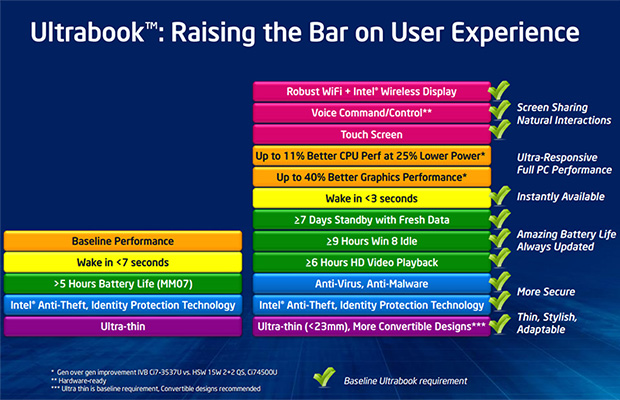It's All About Mobile
Reinforcing just how important the ultra-mobile market is to Intel, the chip giant will also be rolling out Haswell in specific BGA packages for Ultrabooks and other ultra-thin devices.
In keeping with Ivy Bridge, many Haswell processors will ship as a traditional two-chip solution; a CPU (Central Processing Unit) coupled with a PCH (Platform Controller Hub) on the accompanying chipset.
This two-chip configuration will continue to serve the majority of the desktop product line, as well as H- and M-Series mobile processors, but U- and Y-Series parts designed exclusively for ultra-thin devices will take the form of a new one-chip BGA solution. Integrating the two components into a single package should drive innovation in ultra-thin, ultra-portable form factors, and for its low-power U-Series line, Intel is touting a combined CPU+PCH TDP as low as 15W.
What's more interesting, or perhaps confusing, is that Intel's ultra-low-power Y-Series range is moving away from the tried-and-trusted TDP (thermal design power) in favour of a new SDP (scenario design power) rating.
Remember, first, that TDP isn't a measure of how much power a processor will draw, but rather an indication of how much cooling the processor will require in order to dissipate heat. Traditionally speaking, the TDP specification represents a worst-case scenario and depicts usage in sustained high-power applications.
With Ivy Bridge, Intel introduced a Configurable TDP (cTDP) that allowed a processor to scale across three TDPs. An OEM could, for example, take a chip with a 17W TDP and choose to run it in a higher-performance 33W 'TDP Up' state by adding extra cooling, or, alternatively, run it in a lower-performance 13W 'TDP Down' state with reduced cooling.
The newfangled SDP - which is only applicable to Y-Series processors - is, in a way, an extension of the Configurable TDP. Only, instead of representing a worst-case scenario, the SDP is used to gauge how much cooling would be required in common consumption or light creation scenarios.
Where the confusion lies is in the fact that a Y-Series Haswell processor with a 6W SDP can ramp up to 11.5W (the TDP) under stressful workloads. It's up to OEMs to manage the requisite amount of cooling or throttling, and it's up to consumers to try and make sense of what's what: given the variance between SDP and TDP, it will be practically impossible to accurately predict battery life and performance.
A New Generation of Ultrabook
Marketing acronyms aside, what consumers can look forward to is a new-and-improved wave of ultra-thin devices, spearheaded, of course, by Intel's own Ultrabook initiative. The third-generation Haswell Ultrabook specification follows in the footsteps of the first- and second-generation platforms by listing the requirements that each and every Ultrabook manufacturer needs to meet.
As expected, the list has been expanded to ensure that the third-generation Ultrabook experience is the best yet. Working from the top down, Intel's mandate states that all third-generation Ultrabooks must offer robust WiFi, Intel Wireless Display integration, support for voice control and touchscreen capability. Yep, love it or hate it, each and every Ultrabook will now ship with a touchscreen display.
What's interesting is the 'Robust WiFi' recommendation. Intel didn't choose to elaborate, but ultra-thin chassis did appear to catch out last-generation Ultrabooks, some of which suffered from terrible WiFi performance. This time around, it seems Intel will require a 2+2-antennae configuration.
Elsewhere, we're told to expect better performance in a lower power envelope, a massive increase in graphics performance (more on that later) and faster-than-ever resume from sleep. Confusing matters somewhat, Intel is claiming 'amazing battery life' but now uses different benchmarks, making it impossible to tell how much of an improvement we can really expect. Perhaps this confusion is the entire point.
It's worth noting that the maximum Ultrabook thickness has actually been relaxed from 21mm to 23mm, presumably to allow for more innovation in convertible, two-in-one devices, and Ultrabooks will now require an anti-virus solution as standard. Windows 8 - the Ultrabook operating system of choice - has anti-virus baked into the OS, so here's hoping OEMs don't use the requirement as an excuse for loading third-party bloatware.
Intel's expanded list of requirements suggests that third-generation Ultrabooks will be more powerful and feature-packed than ever before, but the addition of mandatory features such as touchscreens isn't going to help costs. For the time being, at least, Ultrabooks are likely to remain premium solutions.












